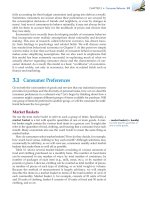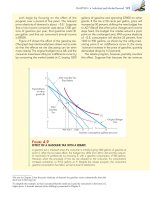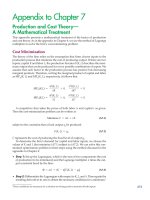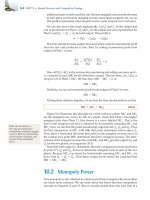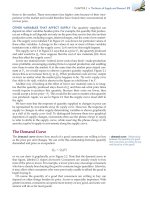(8th edition) (the pearson series in economics) robert pindyck, daniel rubinfeld microecon 752
Bạn đang xem bản rút gọn của tài liệu. Xem và tải ngay bản đầy đủ của tài liệu tại đây (96.48 KB, 1 trang )
ANSWERS TO SELECTED EXERCISES • 727
b. With marginal cost of $30, the optimal prices and
profits are
PRICE 1
PRICE 2
BUNDLED
PROFIT
Sell separately
$80.00
$80.00
—
$200.00
Pure bundling
—
—
$120.00
240.00
120.00
249.90
Mixed bundling
94.95
94.95
several brands with different prices and characteristics is one method of splitting the market into sets of
customers with different price elasticities.
3. a. To maximize profit p = 53Q - Q2 - 5Q, we find
⌬p/⌬Q = - 2Q + 48 = 0. Q = 24, so P = 29. Profit
is equal to 576.
b. P = 53 Q1 - Q2, p 1 = PQ1 - C(Q) = 53Q1 - Q 21 Q1Q2 - 5Q1 a n d p2 = PQ2 - C(Q2) = 53Q2 Q1Q2 - Q22 - 5Q2.
c. The problem facing Firm 1 is to maximize profit, given
that the output of Firm 2 will not change in reaction
to the output decision of Firm 1. Therefore, Firm 1
chooses Q1 to maximize p1, as above. The change in p1
with respect to a change in Q1 is 53 - 2Q1 - Q2 - 5 = 0,
implying Q1 = 24 - Q2/2. Since the problem is symmetric, the reaction function for Firm 2 is Q2 = 24 - Q1/2.
Now mixed bundling dominates all other strategies.
CHAPTER 11—APPENDIX
2.
We examine each case, then compare profits.
a. Optimal quantities and prices with no external market for engines are QE = QA = 2000, PE = $8000,
and PA = $18,000. For the engine-building division,
TR = 2000 # $8000 = $16M, TC = 2(2000)2 = $8M,
and pE = $8M. For the automobile-assembly division, TR = 2000 # $18,000 = $36M, TC = $8000 #
2000 + 16M = $32M, and pA = $4M. Total profits
are $12M.
b. Optimal quantities and prices with an external market
for engines are QE = 1500, QA = 3000, PE = $6000,
and PA = $17,000. For the engine-building division, TR = 1500 # $6000 = $9M, TC = 2(1500)2 =
$4.5M, and p = $4.5M. For the automobileassembly division, TR = 3000 # $17,000 = $51M,
TC = (8000 + 6000)3000 = $42M, and p = $9M.
Total profits are $13.5M.
c. Optimal quantities and prices with a monopoly
market for engines are QE = 2200, QA = 1600,
PE = $8800, and PA = $18,400, with 600 engines
sold in the monopolized market for $9400. For the
engine-building division, TR = 1600 # $8800 +
600 # 9400 = $19.72M, TC = 2(2200)2 = $9.68M, and
p = $10.04M. For the automobile-assembly division,
TR = 1600 # $18,400 = TR = 1600 # $18,400 =
$29.44M, TC = (8000 + 8800)1600 = $26.88M, and
p = $2.56M. Total profits are $12.6M.
The upstream division, building engines, earns the
most profit when it has a monopoly on engines. The
downstream division, building automobiles, earns the
most when there is a competitive market for engines.
Given the high cost of engines, the firm does best
when engines are produced at the lowest cost with an
external, competitive market for engines.
CHAPTER 12
1.
Each firm earns economic profit by distinguishing
its brand from all other brands. If these competitors
merge into a single firm, the resulting monopolist
would not produce as many brands as would have
been produced before the merger. But, producing
d. Solve for the values of Q1 and Q2 that satisfy both reaction functions: Q1 = 24 - (1/2)(24 - Q1/2). So, Q1 = 16
and Q2 = 16. The price is P = 53 - Q1 - Q2 = 21. Profit
is p1 = p2 = P · Qi - C(Qi) = 256. Total profit in the
industry is p1 + p2 = 512.
5.
True. The reaction curve of Firm 2 will be q2 = 7.5 1/2q1 and the reaction curve of Firm 1 will be q1 =
15 - 1/2q2. Substituting yields q2 = 0 and q1 = 15. The
price will be 15, which is the monopoly price.
7. a. (i) In a Cournot equilibrium, when firm A has an
increase in marginal cost, its reaction function shifts
inward. The quantity produced by firm A will
decrease and the quantity produced by firm B will
increase. Total quantity produced will decrease and
price will increase. (ii) In a collusive equilibrium,
the two firms will collectively act like a monopolist.
When the marginal cost of Firm A increases, Firm A
will reduce its production to zero, because Firm B
can produce at a lower marginal cost. Because Firm B
can produce the entire industry output at a marginal
cost of $50, there will be no change in output or price.
However, the firms will have to come to some agreement on how to share the profit earned by B. (iii)
Because the good is homogeneous, both produce
where price equals marginal cost. Firm A increases
price to $80 and firm B raises its price to $79.99.
Assuming firm B can produce enough output, it will
supply the entire market.
b. (i) The increase in the marginal cost of both firms shifts
both reaction functions inward. Both firms decrease
output, and price will increase. (ii) When marginal
cost increases, both firms will produce less and price
will increase, as in the monopoly case. (iii) Price will
increase and quantity produced will decrease.
c. (i) Both reaction functions shift outward and both
firms produce more. Price will increase. (ii) Both firms
will increase output, and price will also increase. (iii)
Both firms will produce more. Because marginal cost
is constant, price will not change.

